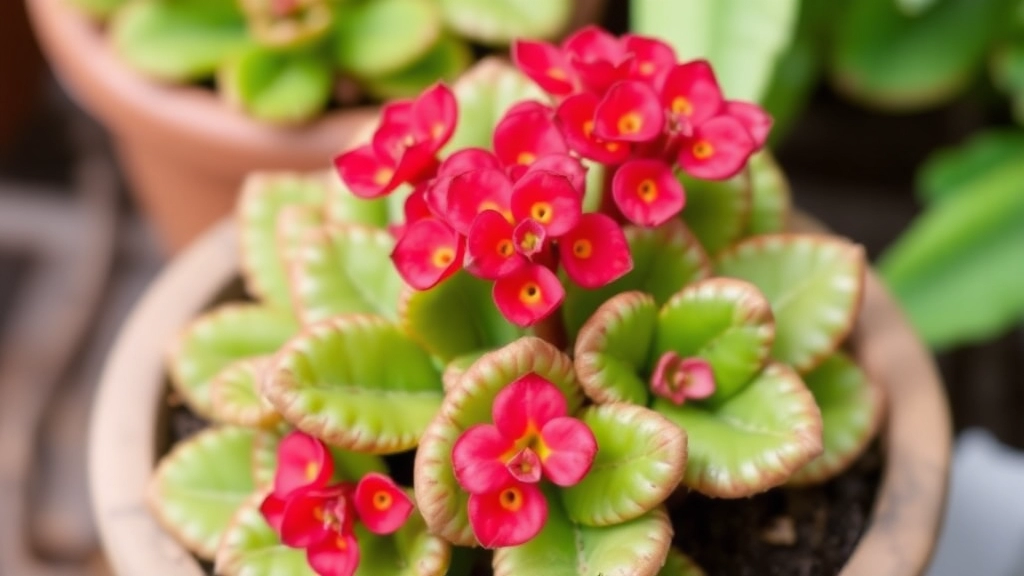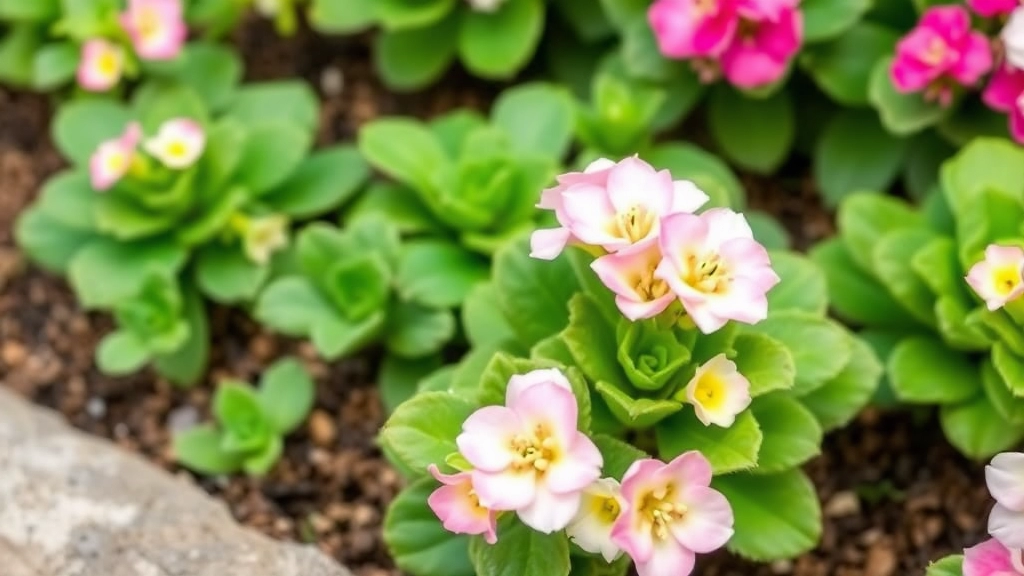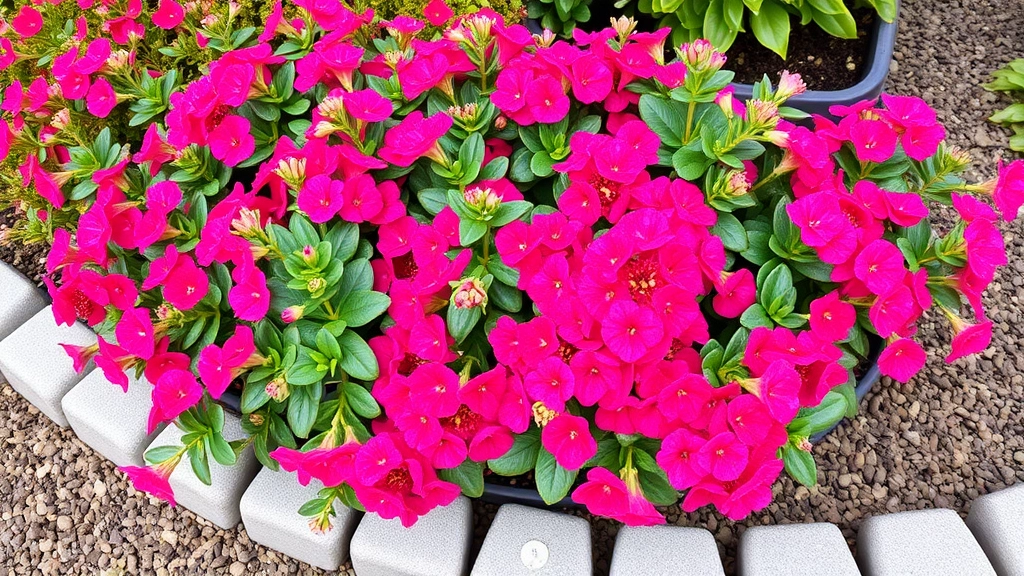Kalanchoe in Flower Beds
When it comes to adding a splash of colour to your garden, Kalanchoe in flower beds is a fantastic choice. This resilient plant thrives in various outdoor conditions and requires minimal maintenance. By selecting the right Kalanchoe varieties and understanding their care needs, you can create a vibrant and long-lasting display in your garden.
Growing Kalanchoe Successfully
To grow Kalanchoe successfully, start with well-draining soil and a sunny spot. Regular watering and occasional fertilisation will keep your plants healthy and blooming. Pruning and pest management are also essential to maintain their beauty. With a bit of attention, your Kalanchoe flower bed can become the star of your garden.
Choosing the Right Kalanchoe Varieties for Flower Beds
When considering the beauty and vibrancy of your outdoor flower beds, the choice of Kalanchoe varieties can make all the difference.
What should you look for?
- Kalanchoe Blossfeldiana: Known for its bright, clustered blooms, this variety is perfect for adding a pop of colour. Its flowers come in various shades, including pink, red, and yellow. For more detailed care tips, check out our Flaming Katy Kalanchoe Blossfeldiana care guide.
- Kalanchoe Tomentosa: Also called the “Panda Plant,” this variety features fuzzy leaves with a unique appearance. While its flowers are less prominent, the foliage adds texture to your garden. Learn how to properly care for this variety in our Panda Plant Kalanchoe Tomentosa care guide.
- Kalanchoe Luciae: Commonly known as the “Flapjack” plant, this variety has striking, flat, and paddle-like leaves that can turn a vibrant red under the right conditions.
- Kalanchoe Thyrsiflora: This variety is another excellent choice with its rosette shape and clusters of yellow flowers. It’s also drought-tolerant, making it a low-maintenance option.
- Kalanchoe Marmorata: Known for its marbled leaves, this variety adds visual interest even when not in bloom. Its flowers are less frequent but still a delightful surprise.
Key Considerations:
- Climate Compatibility: Ensure the variety you choose can thrive in your local climate.
- Sun Exposure: Some Kalanchoe varieties prefer full sun, while others can tolerate partial shade.
- Height and Spread: Consider how tall and wide each variety will grow to ensure they fit well in your flower bed design.
Ideal Conditions for Growing Kalanchoe Outdoors

So, you’re excited to get your Kalanchoe thriving in your garden, right? But what do these beauties really need to flourish outdoors? Let’s dive into the ideal conditions for growing Kalanchoe and make sure you set them up for success.
Sunlight
Kalanchoe loves the sun!
- Aim for at least 6 hours of bright, indirect sunlight each day.
- A south-facing spot is usually perfect.
Too much direct sunlight can scorch their leaves, though, so watch for signs of stress.
Soil
The right soil makes all the difference.
- Go for a well-draining soil mix.
- A cactus or succulent mix works wonders.
You want to avoid waterlogged roots, which can lead to rot.
Temperature
Kalanchoe prefers a warm climate.
- Ideal temperatures range from 15°C to 25°C (59°F to 77°F).
- They can tolerate a bit of cooler weather but watch out for frost.
If you live in a colder area, consider bringing them indoors during winter.
Humidity
These plants are pretty adaptable but thrive in lower humidity.
- Aim for 30% to 50% humidity.
- If your area’s too humid, ensure good airflow around your plants.
Space
Kalanchoe can grow quite bushy, so give them room to breathe.
- Space them about 30cm apart to allow for air circulation and growth.
This helps prevent pests and diseases.
When it comes to nurturing Kalanchoe in your garden beds, understanding the right watering and fertilization practices is essential. Many gardeners worry about overwatering or under-fertilising their plants, which can lead to poor growth or even plant death.
### Watering Kalanchoe
Kalanchoe is a succulent, which means it stores water in its leaves. This unique characteristic makes it crucial to adopt a careful watering routine:
– **Frequency**: Water your Kalanchoe every 2-3 weeks during the growing season (spring and summer). In winter, reduce watering to once a month.
– **Soil Check**: Always check the top inch of soil. If it feels dry, it’s time to water.
– **Drainage**: Ensure that your soil has good drainage. Kalanchoe is susceptible to root rot if left in soggy soil.
– **Watering Method**: Water at the base of the plant to avoid wetting the leaves, which can lead to fungal issues.
### Fertilization Tips
Fertilizing Kalanchoe can significantly enhance its growth and flowering potential. Here’s how to do it effectively:
– **Type of Fertilizer**: Use a balanced, water-soluble fertilizer, ideally one with a higher phosphorus content to encourage blooming.
– **Frequency**: Fertilize every 4-6 weeks during the growing season. Avoid fertilising in the winter months when the plant is dormant.
– **Dilution**: Always dilute the fertilizer to half the recommended strength to prevent burning the roots.
– **Application**: Apply fertilizer after watering to ensure the nutrients are absorbed without shocking the plant.
For more detailed guidance on specific Kalanchoe varieties, you might find our [complete care guide for Kalanchoe Blossfeldiana](https://planthq.org/flaming-katy-kalanchoe-blossfeldiana-care-guide/) particularly useful. Additionally, if you’re experiencing issues with your plant’s leaves, check out our article on [causes and solutions for brown spots on Kalanchoe leaves](https://planthq.org/causes-and-solutions-for-brown-spots-on-kalanchoe-leaves/).
How to Maintain and Prune Kalanchoe in Garden Beds

When it comes to ensuring your Kalanchoe thrives in your garden beds, maintenance and pruning are essential. You might be wondering how to keep these vibrant plants healthy and encourage their best growth.
Regular Maintenance
- Inspect Regularly: Check your Kalanchoe plants weekly for any signs of stress or disease. Early detection is key.
- Deadheading: Remove spent flowers to promote new blooms. This not only keeps the plant looking tidy but also encourages further flowering.
- Cleaning Leaves: Wipe leaves gently with a damp cloth to remove dust and pests. This helps the plant breathe better and absorb sunlight efficiently.
Pruning Techniques
Pruning is vital for shaping your Kalanchoe and keeping it healthy. Here’s how to do it effectively:
- Timing: The best time to prune Kalanchoe is in early spring, just before the growing season starts.
- Tools: Use clean, sharp scissors or pruning shears to avoid damaging the plant.
- Cutting Method:
- Trim back leggy growth to encourage bushier plants. Aim to cut just above a leaf node.
- Remove any dead or yellowing leaves to prevent disease.
- Shape Maintenance: If your Kalanchoe is sprawling, prune back to maintain a compact shape.
Encouraging Growth
To keep your Kalanchoe flourishing, consider these additional tips:
- Fertilise: Apply a balanced fertiliser every 4-6 weeks during the growing season to provide essential nutrients.
- Mulching: Use organic mulch around the base to retain moisture and suppress weeds.
Managing Common Pests and Diseases Affecting Kalanchoe
As we delve deeper into the care of Kalanchoe, it’s essential to address the challenges posed by pests and diseases.
Common Pests to Watch For
Kalanchoe can attract various pests, which can hinder their growth and vibrancy. Here are some common culprits:
– **Aphids**: Tiny green or black insects that suck the sap from leaves, causing wilting.
– **Mealybugs**: White, cottony masses found in leaf joints or on stems, leading to yellowing leaves.
– **Spider Mites**: Microscopic pests that create fine webbing; they thrive in dry conditions.
– **Scale Insects**: Small, brown bumps on stems and leaves, sucking nutrients and weakening the plant.
Signs of Infestation
– Yellowing leaves
– Stunted growth
– Visible pests or webbing
Effective Management Strategies
To keep your Kalanchoe healthy, consider these proactive steps:
1. **Regular Inspection**: Check your plants weekly for any signs of pests.
2. **Natural Remedies**: Use insecticidal soap or neem oil for mild infestations.
3. **Physical Removal**: Wipe leaves with a damp cloth or use a soft brush to remove pests.
4. **Encourage Beneficial Insects**: Ladybugs and lacewings can help control pest populations.
Common Diseases to Monitor
Kalanchoe can also fall victim to diseases, particularly if conditions are not optimal. Key diseases include:
– **Powdery Mildew**: A white, powdery fungus that thrives in humid conditions.
– **Root Rot**: Caused by overwatering, leading to mushy roots and plant decline.
Preventive Measures
– **Proper Watering**: Ensure your Kalanchoe is not sitting in water; allow the soil to dry out between watering.
– **Good Air Circulation**: Space plants adequately to promote airflow, reducing humidity levels around them.
– **Sanitise Tools**: Clean gardening tools to prevent disease spread.
By staying vigilant and implementing these strategies, you can significantly reduce the risk of pests and diseases affecting your Kalanchoe. For more detailed guidance, check out our [ultimate guide to growing Kalanchoe pink flowers](https://planthq.org/ultimate-guide-to-growing-kalanchoe-pink-flowers/) and learn about the [causes and solutions for brown spots on Kalanchoe leaves](https://planthq.org/causes-and-solutions-for-brown-spots-on-kalanchoe-leaves/).
Encouraging Reblooming of Kalanchoe in Outdoor Settings
So, you’ve got your Kalanchoe blooming beautifully, but how do you keep that floral show going?
After all, who doesn’t want a garden that keeps on giving?
Here’s how to encourage your Kalanchoe to rebloom outdoors.
1. Light, Light, Light!
Kalanchoe loves the sun.
Make sure they’re getting at least 6 hours of bright, indirect sunlight each day.
If they’re not getting enough light, they might just sulk and stop blooming.
2. Prune Wisely
After the first bloom, it’s time to get snippy.
- Cut back spent flowers to encourage new growth.
- Remove any dead or yellowing leaves.
This helps the plant focus its energy on producing new blooms instead of wasting it on old flowers.
3. Watering Routine
Overwatering is a common mistake.
- Water only when the top inch of soil feels dry.
- Ensure your pots have proper drainage to avoid soggy roots.
Too much water can lead to root rot, which is a real buzzkill for blooming.
4. Fertilize for Success
Feed your Kalanchoe with a balanced, water-soluble fertiliser.
- Use a fertiliser high in potassium to promote blooming.
- Apply every 4-6 weeks during the growing season.
This gives your plants the nutrients they need to keep those flowers coming.
5. Temperature Matters
Kalanchoe prefers a cozy environment.
- Keep them in temperatures between 15°C to 25°C.
- Avoid placing them in areas with sudden drafts or extreme temperature changes.
A stable environment helps them feel secure enough to bloom again.
6. Rest Period
Just like us, Kalanchoe needs a break.
- Allow your plants a period of dormancy after their first bloom.
- Reduce watering and stop fertilising for about 6 weeks.
This helps them recharge and get ready for the next round of flowers.
For more detailed advice, check out our Kalanchoe Paddle Plant Flower Care Guide and learn about the Health Benefits of Kalanchoe Pinnata.
FAQs on Growing and Maintaining Kalanchoe in Flower Beds
What are the ideal sunlight conditions for Kalanchoe in a flower bed?
Kalanchoe thrives with at least 6 hours of bright, indirect sunlight each day. A south-facing spot is usually perfect. Be cautious of too much direct sunlight as it can scorch their leaves.
What type of soil is best for Kalanchoe?
Kalanchoe prefers a well-draining soil mix. A cactus or succulent mix works wonders to avoid waterlogged roots, which can lead to rot.
What temperatures are suitable for Kalanchoe?
The ideal temperature range for Kalanchoe is 15°C to 25°C (59°F to 77°F). They can tolerate cooler weather but should be protected from frost. In colder areas, consider bringing them indoors during winter.
What humidity levels are best for Kalanchoe?
Kalanchoe thrives in lower humidity levels, ideally between 30% to 50% humidity. Ensure good airflow around the plants if your area is too humid.
How much space should be given to Kalanchoe in a flower bed?
Space Kalanchoe plants about 30cm apart to allow for air circulation and growth. This helps prevent pests and diseases.
How often should I inspect my Kalanchoe plants?
Inspect your Kalanchoe plants weekly for any signs of stress or disease. Early detection is key to maintaining their health.
What is the best way to prune Kalanchoe?
The best time to prune Kalanchoe is in early spring, just before the growing season starts. Use clean, sharp scissors or pruning shears to avoid damaging the plant. Trim back leggy growth and remove any dead or yellowing leaves to maintain a compact shape.
How can I encourage my Kalanchoe to grow better?
To encourage growth, apply a balanced fertiliser every 4-6 weeks during the growing season. Additionally, use organic mulch around the base to retain moisture and suppress weeds.
What maintenance steps are essential for Kalanchoe in garden beds?
Regular maintenance includes inspecting plants weekly, deadheading spent flowers, and cleaning leaves gently with a damp cloth to remove dust and pests. This ensures the plant can breathe better and absorb sunlight efficiently.
References
-
Kalanchoe Plant Care â How To Grow A Kalanchoe
-
How to Grow and Care for Kalanchoe
-
Kalanchoe Plant Care Guide
